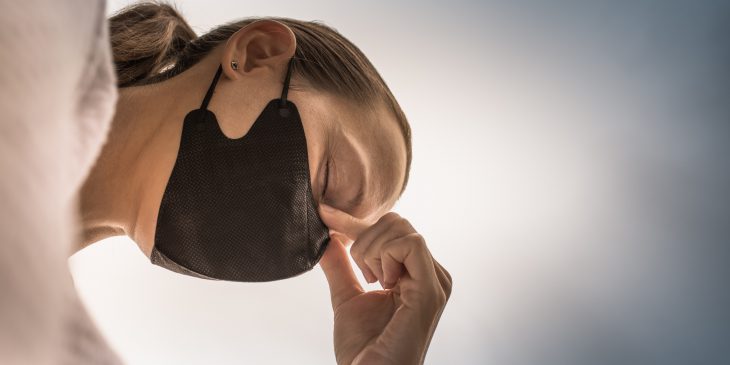Our daily lives now involve wearing face masks, whether for work, shopping or even exercising. Mask wearing is key in protecting ourselves and others from COVID-19, but it can provoke significant psychological responses in many of us.
How can we navigate this?

Helen Wood, DClinPsy
Cognitive behavioral therapy (CBT) can help us understand our own and others’ responses to masks. CBT looks at thoughts, emotions, physiological responses and behaviors that may be triggered by an event, such as mask wearing. These responses often form a vicious cycle. Thoughts that might be evoked include:
- • I’m having difficulty breathing.
• I’m restricted.
• I can’t communicate.
• I might get COVID-19 or give it to someone else.
• I’ve lost connection with others.
Related emotions might range from mild irritation to sadness, vulnerability or fear. Physiologically, we may also feel hot due to the heat sensitivity of the face area covered by the mask. Anxiety or fear may increase our heart rate, contributing to sweating and rapid, shallow breathing, which we may interpret as evidence that we cannot breathe. Behaviorally, we may try to avoid mask wearing or keep removing it, compromising safety for ourselves and others.
Mask wearing can also disrupt our interpersonal threat appraisal system since we’re missing typical facial clues and sometimes clarity of speech in others. Wearing a mask may also evoke a stress response linked to past traumatic experiences, such as those related to medical procedures (such as cancer treatment) and experiences of the mouth being covered or of not being able to breathe.
What can we do to cope or to support others’ coping?
First, normalization and psychoeducation may help — these responses make sense and are understandable. The discomfort of new things tends to ease with time, and practicing mask wearing in the comfort of your home may help. Secondly, we can try to interrupt the vicious cycle mentioned above. Here are some suggestions:
- • Try breathing in through your nose, concentrating on breathing from the diaphragm, taking a little longer to exhale than to inhale. Practice this with and without the mask.
• Practice a grounding skill to help you be in the present moment. Notice five things you can see, four things you can hear, three you can touch, two you can smell and one you can taste.
• Where context allows, have some fun with materials and colors for masks.
• Listen to soothing or distracting music on headphones when wearing a mask.
• Use self-compassion and kindness towards yourself for self-soothing.
• Remind yourself that these masks are safe, that you are helping others, and they are helping you.
• It may be possible to reframe thoughts: I feel as if I can’t communicate, but I did manage to talk with my colleague, manager or a patient today.
By recognizing these psychological responses and practicing techniques to alleviate our concerns, we can become more comfortable with wearing a mask and manage the responses they might provoke in our everyday lives.
Helen Wood, DClinPsy, is a clinical psychologist in the department of Comprehensive Recovery Services at UPMC Western Behavioral Health.









